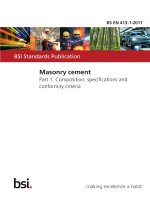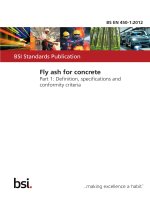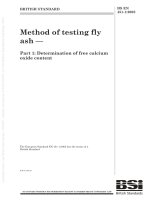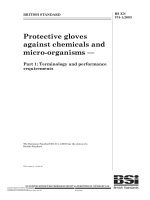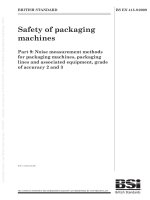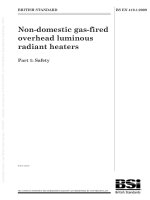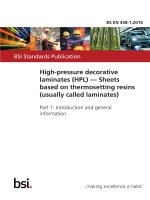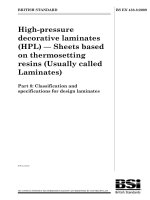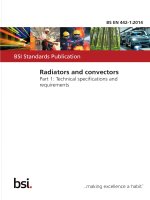Bsi bs en 61073 1 2009
Bạn đang xem bản rút gọn của tài liệu. Xem và tải ngay bản đầy đủ của tài liệu tại đây (1.62 MB, 26 trang )
BS EN 61073-1:2009
BSI British Standards
Fibre optic interconnecting
devices and passive
components — Mechanical
splices and fusion splice
protectors for optical
fibres and cables —
Part 1: Generic specification
NO COPYING WITHOUT BSI PERMISSION EXCEPT AS PERMITTED BY COPYRIGHT LAW
raising standards worldwide™
BRITISH STANDARD
BS EN 61073-1:2009
National foreword
This British Standard is the UK implementation of EN 61073-1:2009. It is
identical to IEC 61073-1:2009. It supersedes BS EN 61073-1:2000 which is
withdrawn.
The UK participation in its preparation was entrusted by Technical Committee
GEL/86, Fibre optics, to Subcommittee GEL/86/2, Fibre optic interconnecting
devices and passive components.
A list of organizations represented on this committee can be obtained on
request to its secretary.
This publication does not purport to include all the necessary provisions of a
contract. Users are responsible for its correct application.
© BSI 2009
ISBN 978 0 580 57184 8
ICS 33.180.20
Compliance with a British Standard cannot confer immunity from
legal obligations.
This British Standard was published under the authority of the Standards
Policy and Strategy Committee on 31 July 2009
Amendments issued since publication
Amd. No.
Date
Text affected
EUROPEAN STANDARD
EN 61073-1
NORME EUROPÉENNE
April 2009
EUROPÄISCHE NORM
ICS 33.180.20
Supersedes EN 61073-1:2000
English version
Fibre optic interconnecting devices and passive components Mechanical splices and fusion splice protectors
for optical fibres and cables Part 1: Generic specification
(IEC 61073-1:2009)
Dispositifs d'interconnexion
et composants passifs à fibres optiques Epissures mécaniques et protecteurs
d'épissures par fusion pour fibres
et câbles optiques Partie 1: Spécification générique
(CEI 61073-1:2009)
Lichtwellenleiter Verbindungselemente
und passive Bauteile Mechanische Spleiße
und Fusionsspleißschutze
für optische Fasern und Kabel Teil 1: Fachgrundspezifikation
(IEC 61073-1:2009)
This European Standard was approved by CENELEC on 2009-02-01. CENELEC members are bound to comply
with the CEN/CENELEC Internal Regulations which stipulate the conditions for giving this European Standard
the status of a national standard without any alteration.
Up-to-date lists and bibliographical references concerning such national standards may be obtained on
application to the Central Secretariat or to any CENELEC member.
This European Standard exists in three official versions (English, French, German). A version in any other
language made by translation under the responsibility of a CENELEC member into its own language and notified
to the Central Secretariat has the same status as the official versions.
CENELEC members are the national electrotechnical committees of Austria, Belgium, Bulgaria, Cyprus, the
Czech Republic, Denmark, Estonia, Finland, France, Germany, Greece, Hungary, Iceland, Ireland, Italy, Latvia,
Lithuania, Luxembourg, Malta, the Netherlands, Norway, Poland, Portugal, Romania, Slovakia, Slovenia, Spain,
Sweden, Switzerland and the United Kingdom.
CENELEC
European Committee for Electrotechnical Standardization
Comité Européen de Normalisation Electrotechnique
Europäisches Komitee für Elektrotechnische Normung
Central Secretariat: avenue Marnix 17, B - 1000 Brussels
© 2009 CENELEC -
All rights of exploitation in any form and by any means reserved worldwide for CENELEC members.
Ref. No. EN 61073-1:2009 E
BS EN 61073-1:2009
EN 61073-1:2009
-2-
Foreword
The text of document 86B/2773/FDIS, future edition 4 of IEC 61073-1, prepared by SC 86B, Fibre optic
interconnecting devices and passive components, of IEC TC 86, Fibre optics, was submitted to the
IEC-CENELEC parallel vote and was approved by CENELEC as EN 61073-1 on 2009-02-01.
This European Standard supersedes EN 61073-1:2000.
The main changes with respect to EN 61073-1:2000 are as follows:
– terms and definitions have been reconsidered;
– style has been added in classification of requirement;
– environmental category has been deleted from classification of requirement;
– standardisation structure and standards interlink have been reconsidered.
The following dates were fixed:
– latest date by which the EN has to be implemented
at national level by publication of an identical
national standard or by endorsement
(dop)
2009-11-01
– latest date by which the national standards conflicting
with the EN have to be withdrawn
(dow)
2010-02-01
Annex ZA has been added by CENELEC.
__________
Endorsement notice
The text of the International Standard IEC 61073-1:2009 was approved by CENELEC as a European
Standard without any modification.
__________
BS EN 61073-1:2009
EN 61073-1:2009
-3-
Annex ZA
(normative)
Normative references to international publications
with their corresponding European publications
The following referenced documents are indispensable for the application of this document. For dated
references, only the edition cited applies. For undated references, the latest edition of the referenced
document (including any amendments) applies.
NOTE When an international publication has been modified by common modifications, indicated by (mod), the relevant EN/HD
applies.
Publication
Year
IEC 60027
Series Letter symbols to be used in electrical
technology
IEC 60050-731
-
IEC 60617
Series Graphical symbols for diagrams
1)
1)
Title
International Electrotechnical Vocabulary
(IEV) Chapter 731: Optical fibre communication
Year
EN 60027
Series
-
-
-
-
EN 60695-11-5
2005
EN 60793-1
Series
2)
IEC 60695-11-5
-
IEC 60793-1
(mod)
Series Optical fibres Part 1: Measurement methods and test
procedures
IEC 60825-1
-
1)
Safety of laser products Part 1: Equipment classification and
requirements
EN 60825-1
2007
2)
IEC 61300-1
-
1)
Fibre optic interconnecting devices and
passive components - Basic test and
measurement procedures Part 1: General and guidance
EN 61300-1
2003
2)
IEC 61300-2
Series Fibre optic interconnecting devices and
passive components - Basic test and
measurement procedures Part 2: Tests
EN 61300-2
Series
IEC 61300-3
Series Fibre optic interconnecting devices and
passive components - Basic test and
measurement procedures Part 3: Examinations and measurements
EN 61300-3
Series
IEC/TR 61930
-
1)
Fibre optic graphical symbology
-
-
-
1)
Fibre optic - Terminology
-
-
-
1)
IEC Quality Assessment System for
Electronic Components (IECQ) Rules of Procedure Part 3: Approval procedures
-
-
IEC/TR 61931
IEC QC 001002-3
1)
Undated reference.
2)
Valid edition at date of issue.
Fire hazard testing Part 11-5: Test flames - Needle-flame test
method - Apparatus, confirmatory test
arrangement and guidance
EN/HD
BS EN 61073-1:2009
EN 61073-1:2009
Publication
-4-
Year
Title
EN/HD
Year
Electronic components - Specification
structures for quality assessment
(Qualification approval and capability
approval)
-
-
IEC Guide 102
-
1)
ISO 129-1
-
1)
Technical drawings - Indication of
dimensions and tolerances Part 1: General principles
-
-
ISO 286-1
-
1)
ISO system of limits and fits Part 1: Bases of tolerances, deviations and fits
-
ISO 1101
-
1)
Geometrical Product Specifications (GPS) - EN ISO 1101
Geometrical tolerancing - Tolerances of form,
orientation, location and run-out
2005
ISO 8601
-
1)
Data elements and interchange formats Information interchange - Representation of
dates and times
-
-
2)
IEC 61073-1
Edition 4.0
2009-01
INTERNATIONAL
STANDARD
Fibre optic interconnecting devices and passive components – Mechanical
splices and fusion splice protectors for optical fibres and cables –
Part 1: Generic specification
INTERNATIONAL
ELECTROTECHNICAL
COMMISSION
ICS 33.180.20
® Registered trademark of the International Electrotechnical Commission
PRICE CODE
R
ISBN 2-8318-1023-0
BS EN 61073-1:2009
–2–
61073-1 © IEC:2009(E)
CONTENTS
FOREWORD...........................................................................................................................3
1
Scope ...............................................................................................................................5
2
Normative references........................................................................................................5
3
Terms and definitions .......................................................................................................6
4
Requirements ...................................................................................................................7
4.1
4.2
4.3
4.4
4.5
4.6
4.7
4.8
4.9
Classification ...........................................................................................................7
4.1.1 Type ............................................................................................................8
4.1.2 Arrangement ................................................................................................8
4.1.3 Style ............................................................................................................8
4.1.4 Variant.........................................................................................................9
4.1.5 Assessment level ....................................................................................... 10
4.1.6 Normative reference extensions ................................................................. 10
Documentation ...................................................................................................... 11
4.2.1 Symbols..................................................................................................... 11
4.2.2 Specification system .................................................................................. 11
4.2.3 Drawings ................................................................................................... 13
4.2.4 Performance .............................................................................................. 13
4.2.5 Measurements ........................................................................................... 13
4.2.6 Test reports ............................................................................................... 13
4.2.7 Instructions for use .................................................................................... 14
Standardisation system .......................................................................................... 14
4.3.1 Performance standards .............................................................................. 14
4.3.2 Reliability standards ................................................................................... 14
4.3.3 Interlinking................................................................................................. 15
Design and construction ........................................................................................ 16
4.4.1 Materials.................................................................................................... 16
4.4.2 Workmanship ............................................................................................ 16
Performance.......................................................................................................... 17
Identification and marking ...................................................................................... 17
4.6.1 Variant identification number ...................................................................... 17
4.6.2 Component marking................................................................................... 17
4.6.3 Package marking ....................................................................................... 17
Packaging ............................................................................................................. 18
Storage conditions ................................................................................................. 18
Safety.................................................................................................................... 18
Figure 1 – Standardisation structure ...................................................................................... 16
Table 1 – Example of a typical mechanical splice and fusion splice protection hardware ......... 8
Table 2 – Three-level specification structure.......................................................................... 12
Table 3 – Standards interlink matrix ...................................................................................... 16
BS EN 61073-1:2009
61073-1 © IEC:2009(E)
–3–
INTERNATIONAL ELECTROTECHNICAL COMMISSION
____________
FIBRE OPTIC INTERCONNECTING DEVICES AND PASSIVE COMPONENTS –
MECHANICAL SPLICES AND FUSION SPLICE PROTECTORS
FOR OPTICAL FIBRES AND CABLES –
Part 1: Generic specification
FOREWORD
1) The International Electrotechnical Commission (IEC) is a worldwide organization for standardization comprising
all national electrotechnical committees (IEC National Committees). The object of IEC is to promote
international co-operation on all questions concerning standardization in the electrical and electronic fields. To
this end and in addition to other activities, IEC publishes International Standards, Technical Specifications,
Technical Reports, Publicly Available Specifications (PAS) and Guides (hereafter referred to as “IEC
Publication(s)”). Their preparation is entrusted to technical committees; any IEC National Committee interested
in the subject dealt with may participate in this preparatory work. International, governmental and nongovernmental organizations liaising with the IEC also participate in this preparation. IEC collaborates closely
with the International Organization for Standardization (ISO) in accordance with conditions determined by
agreement between the two organizations.
2) The formal decisions or agreements of IEC on technical matters express, as nearly as possible, an international
consensus of opinion on the relevant subjects since each technical committee has representation from all
interested IEC National Committees.
3) IEC Publications have the form of recommendations for international use and are accepted by IEC National
Committees in that sense. While all reasonable efforts are made to ensure that the technical content of IEC
Publications is accurate, IEC cannot be held responsible for the way in which they are used or for any
misinterpretation by any end user.
4) In order to promote international uniformity, IEC National Committees undertake to apply IEC Publications
transparently to the maximum extent possible in their national and regional publications. Any divergence
between any IEC Publication and the corresponding national or regional publication shall be clearly indicated in
the latter.
5) IEC provides no marking procedure to indicate its approval and cannot be rendered responsible for any
equipment declared to be in conformity with an IEC Publication.
6) All users should ensure that they have the latest edition of this publication.
7) No liability shall attach to IEC or its directors, employees, servants or agents including individual experts and
members of its technical committees and IEC National Committees for any personal injury, property damage or
other damage of any nature whatsoever, whether direct or indirect, or for costs (including legal fees) and
expenses arising out of the publication, use of, or reliance upon, this IEC Publication or any other IEC
Publications.
8) Attention is drawn to the Normative references cited in this publication. Use of the referenced publications is
indispensable for the correct application of this publication.
9) Attention is drawn to the possibility that some of the elements of this IEC Publication may be the subject of
patent rights. IEC shall not be held responsible for identifying any or all such patent rights.
International Standard IEC 61073-1 has been prepared by subcommittee 86B: Fibre optic
interconnecting devices and passive components, of IEC technical committee 86: Fibre optics.
This fourth edition cancels and replaces the third edition published in 1999. This edition
constitutes a technical revision. The main changes with respect to the previous edition are as
follows:
•
terms and definitions have been reconsidered;
•
style has been added in classification of requirement;
•
environmental category has been deleted from classification of requirement;
•
standardisation structure and standards interlink have been reconsidered.
BS EN 61073-1:2009
61073-1 © IEC:2009(E)
–4–
The text of this standard is based on the following documents:
FDIS
Report on voting
86B/2773/FDIS
86B/2805/RVD
Full information on the voting for the approval of this standard can be found in the report on
voting indicated in the above table.
This publication has been drafted in accordance with the ISO/IEC Directives, Part 2.
The committee has decided that the contents of this publication will remain unchanged until the
maintenance result date indicated on the IEC web site under "" in the data
related to the specific publication. At this date, the publication will be
•
reconfirmed,
•
withdrawn,
•
replaced by a revised edition, or
•
amended.
A bilingual version of this publication may be issued at a later date.
BS EN 61073-1:2009
61073-1 © IEC:2009(E)
–5–
FIBRE OPTIC INTERCONNECTING DEVICES AND PASSIVE COMPONENTS –
MECHANICAL SPLICES AND FUSION SPLICE PROTECTORS
FOR OPTICAL FIBRES AND CABLES –
Part 1: Generic specification
1
Scope
This part of IEC 61073 applies to fibre optic splice hardware (mechanical splices and fusion
splice protections) for optical fibres and cables.
It includes:
–
fibre optic splice hardware requirements;
–
quality assessment procedures.
This standard does not cover test and measurement procedures, which are described in
IEC 61300-1, IEC 61300-2 series and IEC 61300-3 series.
2
Normative references
The following referenced documents are indispensable for the application of this document. For
dated references, only the edition cited applies. For undated references, the latest edition of
the referenced document (including any amendments) applies.
References made to a specific clause or subclause of a standard include all subclauses of the
reference unless otherwise specified.
IEC QC 001002-3, IEC Quality Assessment System for Electronic Components (IECQ) – Rules
of Procedure – Part 3: Approval procedures
IEC Guide 102, Electronic components – Specification structures for quality assessment
(Qualification approval and capability approval)
IEC 60027 (all parts), Letter symbols to be used in electrical technology
IEC 60050-731, International Electrotechnical Vocabulary – Chapter 731: Optical fibre
communication
IEC 60617 (all parts), Graphical symbols for diagrams
IEC 60695-11-5, Fire hazard testing – Part 11-5: Test flames – Needle-flame test method –
Apparatus, confirmatory test arrangement and guidance
IEC 60793-1 (all parts), Optical fibres – Measurement methods and test procedures
IEC 60825-1, Safety of laser products – Part 1: Equipment classification and requirements
IEC 61300-1, Fibre optic interconnecting devices and passive components – Basic test and
measurement procedures – Part 1: General and guidance
BS EN 61073-1:2009
–6–
61073-1 © IEC:2009(E)
IEC 61300-2 (all parts), Fibre optic interconnecting devices and passive components – Basic
test and measurement procedures – Part 2: Tests
IEC 61300-3 (all parts), Fibre optic interconnecting devices and passive components – Basic
test and measurement procedures – Part 3: Examinations and measurements
IEC 61930: Fibre optic graphical symbology
IEC 61931, Fibre optic – Terminology
ISO 129-1, Technical drawings – Indication of dimensions and tolerances – Part 1: General
principles
ISO 286-1, ISO system of limits and fits – Part 1: Bases of tolerances, deviations and fits
ISO 1101, Geometrical Product Specifications (GPS) – Geometrical tolerancing – Tolerances of
form, orientation, location and run-out
ISO 8601, Data elements and interchange formats – Information interchange – Representation
of dates and times
3
Terms and definitions
For the purposes of this document, the terms and definitions contained in IEC 60050-731,
IEC 61931, and IEC 60874-1 as well as the following definitions apply.
3.1
cable joint
protective joint of two or more optical fibre cables. It may consist of fibre splices, organizers
and closures
3.2
capillary mechanical splice
mechanical splice where the fibres are aligned by inserting them in a precision capillary tube
3.3
fibre splice
permanent or separable splice (see separable splice)
3.4
fusion splice
splice in which fibre ends are joined in a permanent manner by means of fusion
3.5
hybrid splice
cable splice with fibre splice(s) and electrical conductor splice(s)
3.6
interchangeable splice sets
splice sets are considered to be interchangeable when they both have the same installation
geometry and functional performance
3.7
mechanical splice
splice in which the fibre ends are joined either permanently or separably by any mechanical
means as long as the fibre ends are not fused together
BS EN 61073-1:2009
61073-1 © IEC:2009(E)
–7–
3.8
permanent splice
splice which cannot be separated
3.9
precision rods mechanical splice
mechanical splice where the fibres are aligned using two or more precision rods
3.10
separable splice
splice which can be disassembled and reassembled but is intended for permanent use
3.11
shape memory alloy splice
mechanical splice where the fibres are aligned by using special materials which have the
property to regain their original macroscopic shape when they are heated up (shape memory
effect) or after an applied load is released, at higher temperature (superelasticity)
3.12
splice protector
protection of bare fibre after the primary coating has been stripped off for the splice procedure
NOTE Additionally, the splice protector reinforces the splice area and provides a possibility to mount this in a
holder.
3.13
splice sub-family
range of fibre optic splice technologies as defined in the relevant specification
3.14
V- groove mechanical splice
mechanical splice where the fibres are aligned by using a precision V-groove
4
Requirements
The requirements for fibre optic splice hardware and accessories covered by this specification
are specified in this clause and in the relevant specification.
4.1
Classification
Fibre optic splice hardware and accessories are classified, either totally or in part, by the
following categories (see Table 1):
–
type;
–
arrangement ;
–
style;
–
variant;
–
assessment level;
–
normative reference extensions.
See Table 1 for an example of a complete fibre optic splice hardware classification.
BS EN 61073-1:2009
61073-1 © IEC:2009(E)
–8–
Table 1 – Example of a typical mechanical splice
and fusion splice protection hardware
Type
Name: V-groove mechanical splice
Name: fusion splice protection
Type of splice: mechanical splice
Type of splice: fusion splice hardware
Configuration: separable splice
Configuration: permanent splice
Arrangement
Kit arrangement with assembling tool
Splice protection kit
Style
Splice method: V-groove
Fibre category: B1, A1
Alignment method: cladding (outside surface, axis)
Single fibre protection
Number of simultaneously spliced fibres: one or
more
Splice protection: shrinkable tubing
Index matching: gel
Fibre coating removal: required, mechanical
Splice protection hardware: sandwich or others
Variants
4.1.1
…………….…..
………………..
Type
Mechanical splices and fibre optic splice hardware shall be defined by the following items.
–
Type name
Example:
“brand name” mechanical splice
“brand name” splice protector
–
Type of splice
Examples: mechanical splice
fusion splice hardware
–
Configuration
Examples: permanent splice
separable splice
4.1.2
Arrangement
The fibre optic splice hardware arrangement shall define the delivered form of the item and the
assembling tool, if needed.
Examples: kit arrangement
splice hardware arrangement
4.1.3
Style
Fibre optic splice style shall be defined by the following items, which may differ depending on
the type of splice hardware.
4.1.3.1
Mechanical splice
Fibre category (according to the series IEC 60793-1)
–
Splice method
Examples: V-groove
BS EN 61073-1:2009
61073-1 © IEC:2009(E)
–9–
capillary tube
ferrule/sleeve
shape memory-based shrinkable tube
precision rod
adhesive bonding
crimping
–
Alignment method
Examples: cladding (outside surface, axis)
core (transmitted power, visual)
self-alignment
secondary reference surface (for example termini)
–
Number of simultaneously spliced fibres
Examples: single/multiple (state the maximum number)
–
Index matching
Examples gel
fluid
cured resin
none
–
Fibre coating removal
Examples: not required
required
• mechanical
• chemical
4.1.3.2
Fusion splice
–
Fibre category (according to the series IEC 60793-1)
–
Number of simultaneously spliced fibres
Examples: single
multiple (state the maximum number)
4.1.3.3
Splice protection hardware
Examples: shrinkable tubing
capillary tubing
metal crimping
gel or fluid
cured resin
injection moulding
sandwich
soft layer
4.1.4
Variant
The splice hardware variants shall define additional features of structurally similar components
(see 3.2).
BS EN 61073-1:2009
– 10 –
61073-1 © IEC:2009(E)
Examples of feature variables which creates variants:
additional fibre and coating sizes accommodated
alternative mounting or fixing points
4.1.5
Assessment level
Assessment level defines the inspection levels and the acceptable quality level (AQL) of
groups A and B and the periodicity of inspection of groups C and D. Detail specifications shall
specify one or more assessment levels, each of which shall be designated by a capital letter.
The following are preferred levels.
–
–
–
Assessment level A
•
Group A inspection:
inspection level II, AQL = 4 %
•
Group B inspection:
inspection level II, AQL = 4 %
•
Group C inspection:
24-month periods
•
Group D inspection:
48-month periods
Assessment level B
•
Group A inspection:
inspection level II, AQL = 1 %
•
Group B inspection:
inspection level II, AQL = 1 %
•
Group C inspection:
18-month periods
•
Group D inspection:
36-month periods
Assessment level C
•
Group A inspection:
inspection level II, AQL = 0,4 %
•
Group B inspection:
inspection level II, AQL = 0,4 %
•
Group C inspection:
12-month periods
•
Group D inspection:
24-month periods
4.1.6
Normative reference extensions
Normative reference extensions are utilised to identify integration of independent standards
specifications or other reference documents into blank detail specifications.
Unless specified exception is noted, additional requirements imposed by an extension are
mandatory. Usage is primarily intended to merge associated components to form hybrid
devices, or can involve integrated functional application requirements that are dependent on
technical expertise other than fibre optics.
Published reference documents produced by ITU consistent with the scope statements of the
relevant IEC specification series may be utilised as extensions. Published documents produced
by other regional standardisation bodies such as TIA, ETSI, JIS, etc., may be referenced in an
informative annex attached to the generic specification.
Some optical fibre splice configurations require special qualification provisions that are not
necessary to impose universally. These accommodate individual component design
configurations, specialised field tooling, or specific application processes. In such cases,
requirements may be necessary to assure repeatable performance or adequate safety, and
provide additional guidance for complete product specification. These extensions are
mandatory whenever utilised to prepare, assemble or install an optical fibre splice, either for
field application usage or preparation of qualification test specimens. The relevant specification
shall clarify all stipulations. However, design- and style-dependent extensions shall not be
imposed universally.
BS EN 61073-1:2009
61073-1 © IEC:2009(E)
– 11 –
In the event of conflicting requirements, precedence shall be given, in descending order, as
follows: generic over mandatory extension, over blank detail, over detail, over application
specific extension.
Examples of requirements in normative extensions include the following:
•
some commercial or residential building applications may require direct reference to
specific safety codes and regulations or incorporate other specific material flammability or
toxicity requirements for specialised locations;
•
specialised field tooling may require an extension to implement specific ocular safety,
electrical shock or burn hazard avoidance requirements, or require isolation procedures to
prevent potential ignition of combustible gases.
4.2
4.2.1
Documentation
Symbols
Graphical and letter symbols shall, whenever possible, be taken from the series IEC 60027, the
series IEC 60617 and IEC 61930.
4.2.2
Specification system
This specification is part of a three-level IEC specification system. Subsidiary specifications
shall consist of blank detail specifications and detail specifications. This system is shown in
Table 2.
BS EN 61073-1:2009
61073-1 © IEC:2009(E)
– 12 –
Table 2 – Three-level specification structure
Specification level
Examples of information to be included
Applicable to
Assessment system rules
Inspection rules
Optical measurement methods
Environmental test methods
Sampling plans
Identification rule
Basic
Two or more component families or
sub-families
Marking standards
Dimensional standards
Terminology
Symbol standards
Preferred number series
SI units
Specific terminology
Specific symbols
Specific units
Preferred values
Generic
Marking
Component family
Quality assessment procedures
Selection test
Qualification approval procedures
Capability approval procedure
Quality conformation test schedule
Blank detail *
Inspection requirements
Information common to a number of types
Groups of types having a common test
schedule
Individual values
Detail
Specific information
Individual type
Completed quality conformance test schedules
*
Blank detail specifications do not, by themselves, constitute a specification level. They are associated to the
generic specification
4.2.2.1
Blank detail specifications
Blank detail specifications do not, by themselves, constitute a specification level. They are
associated to the generic specification.
A blank detail specification shall contain:
–
the minimum mandatory test schedules and performance requirements;
–
one or more assessment levels;
–
the preferred format for stating the required information in the detail specification;
–
the reference normative document, document title and issue date.
4.2.2.2
Detail specifications
Detail specifications shall specify, as a minimum, the following information:
–
type (see 4.1.1);
–
arrangement (see 4.1.2);
–
style (see 4.1.3);
–
variants (see 4.1.4);
BS EN 61073-1:2009
61073-1 © IEC:2009(E)
– 13 –
–
assessment level (see 4.1.5);
–
qualification procedure method (see IECQ procedures);
–
part identification number for each variant (see 4.6.1);
–
drawings, dimensions and performance criteria necessary to produce all required reference
components (see 4.2.3);
–
drawings and dimensions necessary to produce all required gauges (see 4.2.3);
–
quality assessment test schedules (see IECQ procedures);
–
performance requirements (see 4.5).
4.2.3
Drawings
The drawings and dimensions given in detail specification shall not restrict details of
construction nor shall they be used as manufacturing drawings.
4.2.3.1
Projection system
Either first-angle or third-angle projection shall be used for the drawings covered by this
specification. All drawings within a document shall use the same projection system and the
drawings shall state which system is used.
4.2.3.2
Dimensional system
All dimensions shall be given in accordance with ISO 129-1, ISO 286-1 and ISO 1101.
The metric system shall be used in all specifications.
Dimensions shall not contain more than five significant digits.
When units are converted, a note shall be added in each relevant specification and the
conversion between systems of units shall use a factor of 25,4 mm to 1 inch.
4.2.4
Performance
The performance requirements for fibre optic mechanical and fusion splice are defined in the
performance standard series IEC 61753.
4.2.5
4.2.5.1
Measurements
Measurement method
The relevant specification shall define the size measurement method to be used for dimensions
specified within a total tolerance zone of millimetres (0,01 mm) or less.
4.2.5.2
Reference components
Reference components, if required, shall be specified in the relevant specification.
4.2.5.3
Gauges
Gauges, if required, shall be specified in the relevant specification.
4.2.6
Test reports
Test reports shall be prepared for each test conducted. The reports shall be included in the
qualification approval report and in the periodic inspection report.
Test reports shall contain the following information as a minimum:
BS EN 61073-1:2009
– 14 –
61073-1 © IEC:2009(E)
–
title of test and date;
–
specimen description, including the type of fibre. The description shall also include the
variant identification number (see 4.6.1);
–
test equipment used and date of latest calibration;
–
all applicable test details;
–
all measurement values and observations;
–
sufficiently detailed documentation to provide traceable information for failure analysis.
4.2.7
Instructions for use
Instructions for use shall be given by the manufacturer and shall consist of
–
assembly and termination instructions;
–
cleaning method;
–
additional information as necessary.
4.3
Standardisation system
4.3.1
Performance standards
Performance standards contain a series of test and measurement sets (which, depending on
the requirements of that standard, may or may not be grouped into a specified schedule) with
clearly defined conditions, severities and pass/fail criteria. The tests are intended to be run on
a “once-off” basis to prove a given product’s ability to satisfy the “performance standards”
requirement. Each performance standard has a different set of tests and/or severities (and/or
groupings), and represents the requirements of a market sector, user group or system location.
A product that has been shown to meet all the requirements of a performance standard can be
declared as complying with a performance standard, but should then be controlled by a quality
assurance /quality conformance programme.
4.3.2
Reliability standards
Reliability standards are intended to ensure that a component can meet performance
specifications under stated conditions for a stated time period.
For each type of component, the following need to be identified (and appear in the reliability
standard):
–
failure modes (observable general mechanical or optical effects of failure);
–
failure mechanisms (general causes of failure, common to several components); and
–
failure effects (detailed causes of failure, specific to component).
These are all related to environmental and material aspects.
Initially, just after component manufacture, there is an “infant mortality phase” during which
many components would fail if they were deployed in the field. To avoid early field failure, all
components may be subjected to a screening process in the factory, involving environmental
stresses that may be mechanical, thermal or humidity-related. This involves inducing known
failure mechanisms in a controlled environmental situation to occur earlier than would normally
be the case in an unscreened population. For those components that survive (and are then
sold), there is a reduced failure rate, since these mechanisms have been eliminated.
Screening is an optional part of the manufacturing process, rather than a test method. It will
not affect the “useful life” of a component, defined as the period during which it performs
according to specifications. Eventually other failure mechanisms appear, and the failure rate
BS EN 61073-1:2009
61073-1 © IEC:2009(E)
– 15 –
increases beyond a specifically defined threshold. At this point the useful life of the component
ends and the “wear-out region” begins, and the component must be replaced.
At the beginning of the useful life, performance testing on a sampled population of components
may be applied by the supplier, by the manufacturer, or by a third party. This is to ensure that
the component meets performance specifications over the range of intended environments at
this initial point in time. Reliability testing, on the other hand, is applied to ensure that the
component meets performance specifications for at least a specified minimum useful lifetime
or a specified maximum failure rate. These tests are usually carried out by utilising the
performance testing, but increasing duration and severity to accelerate the failure mechanisms.
A reliability theory relates component reliability testing to component parameters and to lifetime
or failure rate under testing. The theory then extrapolates these to lifetime or failure rate under
less stressful service conditions. The reliability specifications include values of the component
parameters needed to ensure the specified minimum lifetime or maximum failure rate in
service.
4.3.3
Interlinking
The standards currently under preparation are given in Figure 1. A large number of the test and
measurement standards are already in place. The quality assurance/qualification approval
standards produced under the banner of the IECQ have already been in place for many years.
As previously mentioned, other alternative methods of quality assurance/quality conformance
are being developed under the rubrics of Capability Approval and Technology Approval which
are covered by IEC QC 001002-3 and IEC Guide 102.
With regard to performance and reliability standards, the matrix given in Table 3 demonstrates
some of the options available for product standardisation once these two standards are in
place.
Product A is fully IEC standardised and meeting defined performance and reliability standards
requirements.
Product B is a product which complies with a performance standard, but does not meet any
reliability requirements.
Product C is a product which does not meet the requirement of either an IEC performance or
reliability standard.
In addition, the products may all be subject to a quality assurance programme that could be
conducted under IEC Qualification, Capability or Technology Approval, or even under a
national or company quality assurance system.
BS EN 61073-1:2009
61073-1 © IEC:2009(E)
– 16 –
Test and
measurement
Performance
Reliability
Quality
IEC 61300-XX
(IEC 60068-XX)
IEC 61753-XX
IEC 62005-XX
QC 001002-3
IEC
specification
structure:
------------------Generic
specification
Blank detail
specification
Detail
specification
IEC
2302/08
Figure 1 – Standardisation structure
Table 3 – Standards interlink matrix
4.4
Performance
standard
Reliability
standard
Product A
YES
YES
Product B
YES
NO
Product C
NO
NO
Design and construction
4.4.1
4.4.1.1
Materials
Corrosion resistance
All materials used in the construction of mechanical splice and fusion splicer protector sets
shall meet the requirements of the relevant specification.
4.4.1.2
Non-flammable materials
When non-flammable materials are required, the requirement shall be specified in the
specification, and IEC 60695-11-5 shall be referenced.
4.4.2
Workmanship
Components and associated hardware shall be manufactured to a uniform quality and shall be
free of sharp edges, burrs or other defects liable to affect life, serviceability or appearance.
Particular attention shall be given to neatness and thoroughness of marking, plating, soldering,
bonding, etc.
BS EN 61073-1:2009
61073-1 © IEC:2009(E)
4.5
– 17 –
Performance
Splice hardware and accessories shall meet the performance requirements specified in the
relevant specification.
4.6
Identification and marking
Components, associated hardware, and packages shall be permanently and legibly identified
and marked when required by the relevant specification.
4.6.1
Variant identification number
Each variant in a detail specification shall be assigned an identification number, consisting of
the detail specification number followed by a dash, a four-digit number and a letter designating
the assessment level. The first digit of the four-digit number shall be sequentially assigned to
each component type covered by the detail specification. The other three digits shall be
sequentially assigned to each variant of the component.
EXAMPLE:
QC910101/US001-1 001 A
Detail specification number
Component type
Variant
Assessment level
4.6.2
Component marking
Component marking, if required, shall be specified in the relevant specification. The preferred
order of marking is as follows:
a) supplier’s identification mark;
b) supplier date code;
c) supplier’s part number;
d) variant identification number.
4.6.3
Package marking
Package marking, if required, shall be specified in the relevant specification. The preferred
order of marking is as follows:
a) supplier’s identification mark;
b) supplier’s part number;
c) supplier date code (year/week, see ISO 8601);
d) variant identification number(s) (see 4.6.1);
e) type (see 4.1.1);
f)
assessment level;
g) environmental category;
h) any additional marking required by the relevant specification.
BS EN 61073-1:2009
– 18 –
61073-1 © IEC:2009(E)
When applicable, individual unit packages (within the sealed package) shall be marked with the
reference number of the certified record of released lots, the supplier’s factory identity code
and the component identification.
4.7
Packaging
Packages shall include instructions for use when required by the relevant specification
(see 4.2.6).
4.8
Storage conditions
Where short-term degradable materials, such as adhesives, are supplied with the package of
mechanical splice and fusion splice protector parts, the manufacturer shall mark these with the
expiry date (year and week numbers, see ISO 8601) together with any requirements or
precautions concerning safety hazards or environmental conditions for storage.
4.9
Safety
Optical fibre mechanical splice and fusion splice protectors, when used on an optical fibre
transmission system and/or equipment, may emit potentially hazardous radiation from an
uncapped or unterminated output port or fibre end.
Splice hardware and accessories manufacturers shall make available sufficient information to
alert system designers and mechanical splice and fusion splice protector users about the
potential hazard and shall indicate the required precautions and working practices.
In addition, each relevant specification shall include the following:
WARNING NOTE
Care should be taken when handling small diameter fibres to prevent puncturing the skin, especially in the eye area.
Direct viewing of the end of an optical fibre or an optical fibre mechanical splice and fusion splice protector when it
is propagating energy is not recommended unless prior assurance has been obtained as to the safety energy output
level.
Reference shall be made to IEC 60825-1, the relevant standard on safety.
___________
This page deliberately left blank
